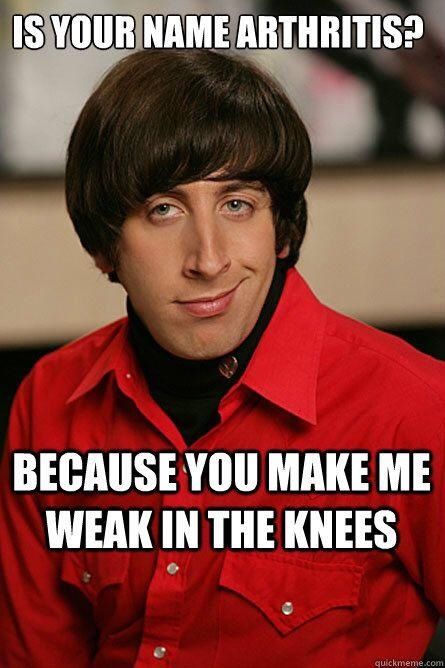Why did the pirate have a peg leg? ARRRRRRRthritis!
What is osteoarthritis (OA)?Think of your joints as swinging like doors - the joint capsule is like the hinge to make sure that the door swings easily and quietly. Over time, the hinge wears down due to a combination of the environment, how often it's used, and any extra pressure or injury to the point where the swinging is stiffer, louder, and the door may not shut completely. The inflammation that occurs in the joint that leads to pain, popping sounds and sensations, and ultimately trouble using the joint, is osteoarthritis (there are some less common forms of arthritis, like rheumatoid arthritis, which is a very different thing, so we'll just talk about osteoarthritis for now).
Who gets osteoarthritis?
Short answer is everybody. Under 35, you have less than 0.1% chance of having it. Over 55, 80% of people have it to some degree. It's a merit badge you get for living longer and a reminder that the wisdom of age is that you don't need to be in such a rush to do things. There are factors that hasten osteoarthritis including:
- being overweight - this is far and away the most modifiable thing that causes OA and its most strongly linked to the knees and hands but has some contribution to all the weight-bearing joints (ankles, hips, lower spine). This ignores whatever your body composition is as joints can't tell the difference between a pound of fat and a pound of muscle - I have seen serious competitive bodybuilders have terrible knee OA.
- Occupations and sports/exercises involving repetitive, high impact exercises such as soccer, football, gymnastics, carpentry and any jobs involving physical labor
- Major joint injuries can lead to earlier onset OA in those joints if it alters what they look like, such as a badly broken ankle after a bike accident.
- Women have a higher propensity towards OA, maybe owing to some protective effect from hormones that gets lost after menopause
How do I know if I have osteoarthritis?
- OA is actually a clinical diagnosis and tests are rarely needed to confirm it in the typical joints that get OA. Being older than 45, having less than 30 minutes of morning stiffness and worsening pain with use is basically the diagnosis for OA most of the time.
- X-rays can see osteoarthritis but sometimes you can OA and have no pain and vice-versa. There are some other conditions that can mimic OA but are usually diagnosed with an exam and related more to things that connect to or abut joints, like bursitis or tendonitis or ligament strains.
What are the treatments for osteoarthritis?
Unfortunately, this being mostly a mechanical problem with the joint, medications are not a great solution. Anti-inflammatory medications like Advil (ibuprofen) or Aleve (naproxen) are OK short term, but since OA is a long term problem and those can cause issues with the heart and kidneys, they aren't good medications to be taking daily.
There is a topical anti-inflammatory gel that helps some for the knee and hands and other things like Ben Gay or Aspercreme that take a little bit of the edge off. Some patients tell me they've had good responses to medicinal marijuana such as CBD oils or other CBD based marijuana concoctions.
Glucosamine/Chondroitin & Turmeric are possible alternative treatments as well - they are over-the-counter and have mixed results depending on whom you ask but generally no side effects.
Non-drug treatments would be more along the lines of weight loss, physical therapy for muscle strengthening, walking aides and braces. Tai chi, Qigong and yoga have all shown modest benefits as well.
Injections can sometimes be helpful short term options as well. Typically now we use corticosteroid injections (you probably have heard these called cortisone shots) - it's like a focused dose of anti-inflammatory medication that's supposed to be longer lasting. If there's a lot of inflammation and if done properly, it can be very helpful. Some people get a lot of benefit from it and some people nothing at all. Generally these can be done every 3 months - any more frequent and you can cause more problems than you solve. The way I do them, they are usually almost pain free too (the secret is the needle thickness, not the length).
There are a lot of other experimental treatments being pitched out there as injections including hyaluronic acid, saline, stem cells and probably more out there but nothing has really been shown to be effective, though that doesn't stop people from charging large amounts of money to give them.
The final solution is a joint replacement, which for knees and hips has been around for a long time, and slowly we are getting more experience with shoulders and ankles and some smaller joints as well. They work really well for most people and relieve a lot of pain, but you do lose some function that you would have with a natural joint. If you feel like you're getting to this point, this is when I usually have you see an orthopedist.
